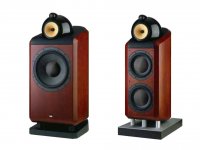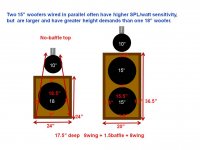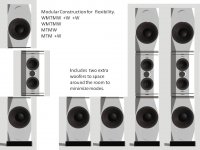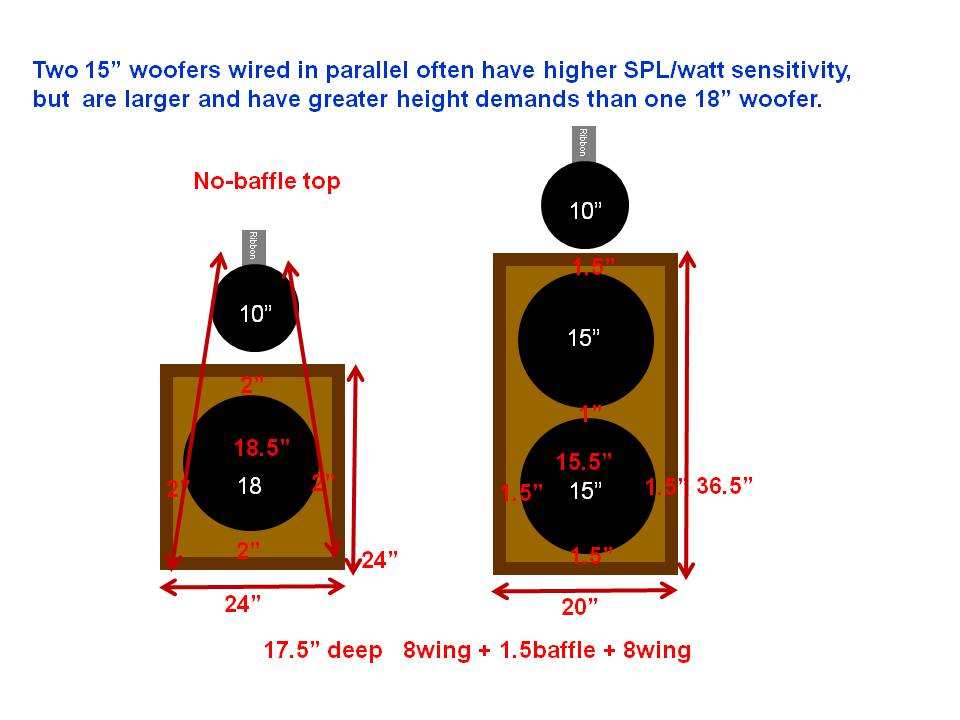When I see grand marques' of loudspeakers....JBL, Infinity.........even Klipsch, walk down that path of the obligatory narrow tower speaker with the "common" 5-7" driver....we all know somethings up.
Call it the commercialization of Hi fidelity, or the bastardization of sound quality, it is all interconnected.
In the early sixties, you would see a teen-ager bobbing his/her head to tunes from an AM "transistor radio" glued to the ear. Fast forward to current times & you see that same teen-ager bobbing the head to the music.........thru his/her I-phone. Both devices sound the same, tinney, compressed, ....small.
"The more things change, the more they stay the same"
It is only thru US..the enthusiast, whereby the sound meandering thru a neighborhood.........the music wafting along as you walk....do you realize, there is no band playing in a garage somewhere....it is a GREAT system somewhere, imitating reality........a breath of fresh air..for the ears.
_______________________________________________________Rick........
Call it the commercialization of Hi fidelity, or the bastardization of sound quality, it is all interconnected.
In the early sixties, you would see a teen-ager bobbing his/her head to tunes from an AM "transistor radio" glued to the ear. Fast forward to current times & you see that same teen-ager bobbing the head to the music.........thru his/her I-phone. Both devices sound the same, tinney, compressed, ....small.
"The more things change, the more they stay the same"
It is only thru US..the enthusiast, whereby the sound meandering thru a neighborhood.........the music wafting along as you walk....do you realize, there is no band playing in a garage somewhere....it is a GREAT system somewhere, imitating reality........a breath of fresh air..for the ears.
_______________________________________________________Rick........
Big woofers "Still" sound better Cal
You know you're preaching to the converted don't you?
You know you're preaching to the converted don't you?
LOL
"Of course"



Me like big woofers
Woof! Woof! Woof! That's my other dog imitation. -Oddball
se
Last edited:
I'm an old-time HiFi enthusiast, long on the electrical theory, but short on speaker tech. Over the years it seems that woofers have gotten smaller and smaller. Are they really kicking out the bass like the old 12 and 15 inch units? Does a foam surround make an 8 inch woofer equivalent to a 12 inch woofer? Bookshelves are shrinking to shoebox. How small can you make a full range speaker?
Bobby Dipole
It's simple. Efficiency and size are tied together. (Google Hoffman's Iron Law.) People have wanted to get good sound from small speakers for decades. The limiting factor has typically been the amplifier. With the advent of cheap high efficiency amplifiers, it's a lot more practical to make VERY small speakers.
Another factor is the ubiquity of underhung neodymium motors, and the shift of speaker manufacturing from the USA to China, and the increase of shipping costs that came with it.
B&W published a white paper for the latest 801 Nautilus with measured data plus listener reviews which made the case that new motor and cone technologies allow one 15" woofer to have superior transient performance over multiple smaller woofers. BUT, one year later B&W started to market the 802 Nautilus which uses two 10" woofers in a much more living room acceptable size, AND this twin 10" model quickly became the best seller. The picture is worth 1,000 words.
Personally, I've been watching for a superior home audio 18" woofer with 96-98 db/watt SPL which can cover 20-300Hz to replace stacked 15" woofers with a smaller(shorter) box. I believe NdFeB radial motors and carbon fiber loaded paper cones will make 18" the new favorite size for efficient DIY bass.
Dr. Geddes has been adding new research on the value of putting multiple woofers in the room to remove resonant modes. This type of room bass solution could provide large volume displacement from four or more modest diameter woofers... say 12".. instead of two monster woofers or two monster bass horns.
Personally, I've been watching for a superior home audio 18" woofer with 96-98 db/watt SPL which can cover 20-300Hz to replace stacked 15" woofers with a smaller(shorter) box. I believe NdFeB radial motors and carbon fiber loaded paper cones will make 18" the new favorite size for efficient DIY bass.
Dr. Geddes has been adding new research on the value of putting multiple woofers in the room to remove resonant modes. This type of room bass solution could provide large volume displacement from four or more modest diameter woofers... say 12".. instead of two monster woofers or two monster bass horns.
Attachments
Another factor is the ubiquity of underhung neodymium motors, and the shift of speaker manufacturing from the USA to China, and the increase of shipping costs that came with it.
You sure those ubiquitous motors are not overhung?
ATC are one of the few manufacturers using underhung motors (though not neodymium) and they require hugely expensive and very large magnets.
Big Air!
It is all a matter of the volume of air displaced [Vd] = [Sd]*[Xmax]
where [Sd] - Effective Diaphragm Area and [Xmax] = zero to peak displacement for 10% distortion.
If excursions become too large in a "full-range" speaker, Doppler (IM) distortion becomes audible. The wizzer cone is riding the LF envelope while following the HF. The crosover here is mechanical and low pass only to LF section.
Regards,
WHG
I'm an old-time HiFi enthusiast, long on the electrical theory, but short on speaker tech. Over the years it seems that woofers have gotten smaller and smaller. Are they really kicking out the bass like the old 12 and 15 inch units? Does a foam surround make an 8 inch woofer equivalent to a 12 inch woofer? Bookshelves are shrinking to shoebox. How small can you make a full range speaker?
Bobby Dipole
It is all a matter of the volume of air displaced [Vd] = [Sd]*[Xmax]
where [Sd] - Effective Diaphragm Area and [Xmax] = zero to peak displacement for 10% distortion.
If excursions become too large in a "full-range" speaker, Doppler (IM) distortion becomes audible. The wizzer cone is riding the LF envelope while following the HF. The crosover here is mechanical and low pass only to LF section.
Regards,
WHG
I detect that the wives themselves are getting bigger. [/IMG]
true...
definitely true, I see it in my case too...
I detect that the wives themselves are getting bigger.

- Status
- This old topic is closed. If you want to reopen this topic, contact a moderator using the "Report Post" button.
- Home
- Loudspeakers
- Multi-Way
- Why are woofers getting so small?





